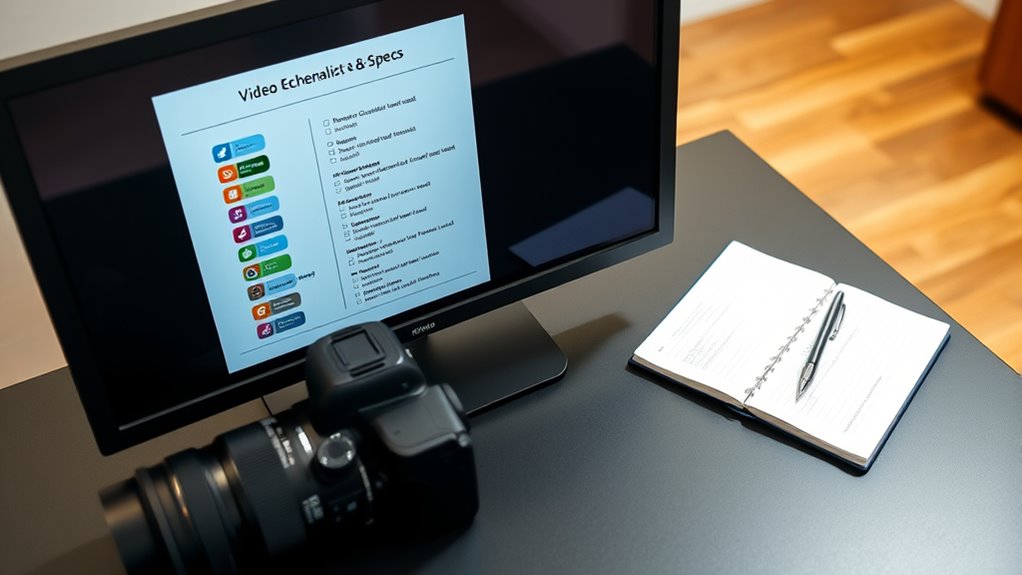To guarantee your video evidence is credible and admissible, start with a checklist including device type, resolution (preferably 4K or HD), frame rate, low-light performance, stabilization, and storage capacity. Document the device’s make, model, date, and conditions when recording. Proper handling and maintaining the device’s integrity are essential. Understanding key specs helps you produce clear, detailed footage that stands up in court. Keep these factors in mind to strengthen your case as you explore more details.
Key Takeaways
- Ensure the device records in high resolution (preferably 4K) for detailed evidence collection.
- Verify key features like frame rate, low-light performance, stabilization, and storage capacity meet investigative needs.
- Regularly calibrate and update the device to maintain recording accuracy and reliability.
- Document device make, model, settings, and recording conditions to establish footage authenticity.
- Use high-quality devices and proper handling to produce credible, court-ready video evidence.

Video evidence has become a powerful tool in shaping legal and investigative processes. When capturing critical moments, the quality of the footage can make all the difference in how your evidence is perceived and accepted. One of the most important factors to consider is video quality, which directly affects the clarity and usefulness of the footage. High-quality videos allow investigators and courts to see details clearly, such as facial features, license plates, or specific actions. If the video is blurry or pixelated, it can be challenged or dismissed, so choosing the right recording devices is essential. Modern recording devices, whether they’re body cameras, security cameras, or smartphones, vary widely in their capabilities. Some devices offer 4K resolution, delivering crisp, detailed images, while others may only record in standard definition. You need to guarantee your recording device’s specifications meet the requirements of your situation, especially if the footage might be scrutinized in court.
When selecting recording devices, pay attention to features like frame rate, low-light performance, and stabilization. A higher frame rate captures more motion detail, which can be critical in fast-paced incidents. Good low-light performance ensures your footage remains clear in dim environments, and stabilization prevents shaky videos that can be difficult to interpret. It’s also worth noting that the storage capacity of your device influences how long you can record without interruption. Many investigators and legal professionals prefer devices with ample storage or the ability to easily transfer footage to secure storage. Additionally, the user interface of your recording device should be straightforward, allowing you to quickly start recording when an incident occurs without fumbling with complicated settings.
Another critical aspect is maintaining the integrity of your recording devices. Regular calibration, updates, and proper handling ensure that your video footage remains reliable and free from tampering. When it comes to establishing the credibility of your video evidence, details about the recording device’s make, model, and settings can help support its authenticity. Always document how and when you recorded footage, including the device used and any relevant conditions. Properly preserved, high-quality recordings can serve as compelling evidence in court, helping to tell a clear, truthful story. Additionally, understanding the contrast ratio of your recording device can influence how well details are captured in scenes with varied lighting conditions. Ultimately, investing in quality recording devices and understanding their specifications isn’t just about capturing footage—it’s about guaranteeing your video evidence holds up under scrutiny and contributes effectively to your legal or investigative efforts.
Frequently Asked Questions
What Are the Legal Standards for Video Evidence Admissibility?
You need to guarantee your video evidence meets legal standards by confirming proper video authentication and maintaining a clear chain of custody. Courts require proof the footage is genuine and unaltered, which involves verifying its origin and handling. By documenting each transfer and ensuring the video remains unmodified, you support its admissibility. Following these standards helps establish credibility and prevents challenges that could weaken your case.
How Should Video Files Be Securely Stored and Preserved?
Your video files are treasures, so you must store them securely. Use robust storage encryption to protect against hacking, guaranteeing they’re safe from unauthorized access. Manage metadata meticulously to maintain chain of custody and authenticity. Regularly back up files in multiple locations, and verify integrity through checksum or hash comparisons. By doing so, you ensure your evidence remains unaltered, trustworthy, and ready for court whenever needed.
What Are Common Challenges in Verifying Video Authenticity?
You often face challenges verifying video authenticity, especially with video manipulation techniques that can alter footage. Metadata analysis helps you detect inconsistencies, but it’s not foolproof since metadata can be tampered with. You need to stay cautious, combining technical tools with expert judgment. Recognizing signs of manipulation and understanding the limits of metadata analysis are vital steps in confirming whether a video is genuine or altered.
How Does Video Quality Impact Evidence Credibility?
Think of video quality as the foundation of a house; if shaky, the entire structure crumbles. When video compression reduces quality or playback resolution drops, it’s harder to trust the evidence. High-quality footage provides clearer details, making it easier to verify authenticity. Conversely, poor quality can hide tampering or distort vital info, undermining credibility. So, maintaining ideal video quality is vital to guarantee your evidence stands on solid ground.
Are There Specific Formats Preferred for Courtroom Presentation?
You should use widely accepted formats like MP4 or MOV for courtroom presentation, as they comply with courtroom protocols and guarantee compatibility with court equipment. Avoid unnecessary video editing that might alter the evidence’s integrity. Stick to original footage or minimally edited clips, and always verify the format beforehand. This way, your video evidence remains credible and easily accessible, meeting courtroom standards and preventing potential technical issues.
Conclusion
By following this checklist and understanding the specs, you guarantee your video evidence stands as a fortress of truth. Remember, clear footage and proper documentation aren’t just details—they’re your strongest allies in court. Think of your video as a lighthouse, guiding justice through the fog of doubt. When you prioritize quality and thoroughness, you turn your footage into a powerful voice that won’t be ignored. Don’t just record—capture with purpose, and let your evidence speak volumes.









